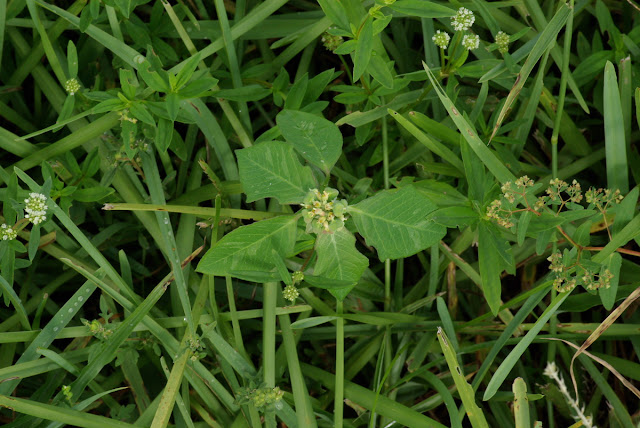This is the second part of a four-part series of blog posts on a short botanical field trip to south Florida.
Our first stop of the field trip was a roadside ditch along U.S. Route 27 in southern Broward County, where it runs beside the eastern edge of the Florida everglades.
Growing in very large patches in the road median and along the sides of the road was Ruellia ciliatiflora, originally native to South America but now becoming common in south Florida. It is distinct from native Ruellia species in its flowers, which are borne in a stalked inflorescence above the uppermost leaves. In contrast, native south Florida Ruellia species bear their sessile (stalkless) or very short-stalked flowers in the axils of the leaves.
 |
| Ruellia ciliatiflora, a native of South America, is spreading in south Florida. |
Joining Ruellia ciliatiflora along the roadsides of U.S. Route 27 was Euphorbia heterophylla, a weedy Florida native plant. The Atlas of Florida Vascular Plants does not list it for Palm Beach County but a colony is present on the grounds of the West Palm Beach headquarters of the South Florida Water Management District, where I work, and it has persisted for at least a decade as a weed in the garden of a friend in Lake Worth. Although Florida has been well botanized, it isn't particularly difficult to find new county records and, in the case of Euphorbia heterophylla, finding the new Palm Beach County record was as easy as going to work or visiting a friend's garden.
 |
| Euphorbia heterophylla (synonym: Poinsettia heterophylla). |
Just a short distance westward from the mowed roadside, in wet depressions that paralleled the west side of U.S. Route 27, there were colonies of the state-listed endangered plant, Lippia stoechadifolia. In places, the colonies extended for thousands of yards and one would scarcely think that it was a particularly rare plant. The genus Lippia closely resembles Phyla but Lippia species have at least some stems that are erect or ascending and become woody with age. In contrast, Phyla has creeping stems, none of which ever become erect and woody.
 |
| Lippia stoechadifolia (synonym: Phyla stoechadifolia) is a state-listed endangered plant recorded only from Broward, Collier, and Miami-Dade counties. |
 |
| Close-up of the tiny flowers of Lippia stoechadifolia. |
Many typical native plants of wet ground were growing with Lippia stoechadifolia but especially notable was Pluchea baccharis (synonym: Pluchea rosea). I had never seen such large, healthy, robust specimens and the dark pink to maroon-pink flowerheads made a pleasing contrast to the whitish upper leaves and bracts of the inflorescences.
 |
| Pluchea baccharis (synonym: Pluchea rosea), formed large freely flowering plants at this site. |
Go to Part 1 of a "South Florida Field Trip."
Go to Part 3 of a "South Florida Field Trip."
Go to Part 4 of a "South Florida Field Trip."
Go to Part 3 of a "South Florida Field Trip."
Go to Part 4 of a "South Florida Field Trip."
Images and text © 2013 Rufino Osorio

No comments:
Post a Comment